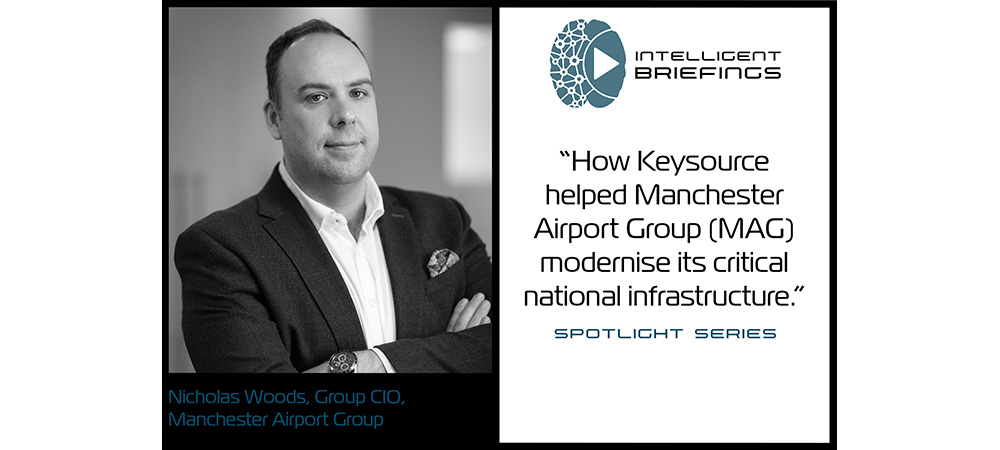Delivering a smart and well-equipped airport that offers exceptional customer experience is a key requirement of any airport that aims to operate successfully. Keysource helped the Manchester Airport Group (MAG) to achieve this and to modernise its critical national infrastructure. Nicholas Woods, Group CIO, Manchester Airport Group, is here to talk about the benefits of the solution in more detail.
The Manchester Airport Group, the UK’s premier Airport Services and Management company, owners and operators of Manchester, East Midlands and London Stansted Airports, has embarked upon an ambitious £1 billion airport transformation programme at Manchester Airport. The project includes a full infrastructure transformation, delivering state-of-the-art hybrid cloud, networks and communications platforms. As part of this £1 billion investment, the transformation of Manchester Airport has seen a significant physical and digital technology modernisation effort, radically improving and redesigning multiple onsite data centres. Keysource, Global Critical Environment Specialist, delivered highly resilient and efficient solutions that will support the vision to make Manchester Airport one of the top 10 airports in Europe.
The project
Underpinning the programme is the progressive modernisation of the core IT infrastructure. This covers the full IT stacks including application, compute, data centre, network and communication. Essential to the unified upgrade of the IT infrastructure was the data centre design completed by Keysource in partnership with MAG IT and other MAG stakeholders. Working together from the early phases was critical to ensure every level of the stack would complement each other and work towards an integrated efficient and resilient service.
Central to this design was the on-premise data centre estate which comprises of hundreds of comms rooms and four core data centres. The design was a blueprint that covered construction, electrical, mechanical, life safety systems, structured cabling, BMS and power monitoring. This blueprint is now being rolled out across both London Stansted Airport and East Midlands Airport to ensure ease of use, maintenance, efficiency and resilience.
Modernising the infrastructure from the ground up with a blueprint design replied upon a new resilient technology infrastructure that would be key to the success of the programme. The decision was made to implement an on-premises data solution driven by a need and desire for control, security and latency as part of a wider hybrid strategy. The project highlights included:
• Construction of the physical rooms
• Electrical resilience with N+1 diverse power to the cabinets
• Mechanical efficiency and resilience with a highly efficient N+1 cooling solution
• Environmentally friendly gaseous suppression systems
• Highly secure, fully integrated access control systems
The challenge
The airport contributes £7 billion to the UK economy every year and so the impact of any downtime or issues could be extremely damaging both financially and reputationally. The modernisation project was successfully deployed across a live airport, handling 29 million passengers a year, where any downtime or impact to IT services would directly affect flights, airport operations, revenue and passengers.
To provide the millions of passengers that use the airport every year with facilities that combine a contemporary look and feel with state-of-the-art services, the project team fully understood the challenges and ensured all risks had been mitigated within the project programme, including:
• Airside security
• Remote airside location two miles from the terminal buildings
• Working around live IT and electrical services supporting countless airport services such as baggage handling
• Live operational data centres with complex migration strategies with 10+ stages in one facility alone, replacing raised floor, racks, power and containment row by row
• Limited time for out of hours switching 01:00 to 04:00 after last flight and before first flight
• Summer moratorium/change freeze windows for existing systems
The results
The Manchester Airport transformation project has enabled and equipped a smarter airport that will deliver an exceptional customer experience going forward. The successful delivery of light construction, electrical, mechanical, racks and thermal containment, fire detection and suppression, structured cabling and BMS took place around live services within a complex IT migration strategy during limited shutdown windows. The data centres are at the heart of all airport operations affecting lights, gates, passenger information and ultimately aircraft take-off and landings. The transformation project has seen zero unplanned outages and delivered:
• Comprehensive critical environment monitoring and control systems plus detailed power monitoring systems for capacity and energy efficiency monitoring
• 99.99% availability level through resilient infrastructure design
• Repeatable blueprint design for all sites
• Minimised Mean Time to Repair (MTTR) with standardised infrastructure across all airports
Nicholas Woods, Group CIO, Manchester Airport Group, tells us more about the implementation process:
Can you give us an overview of company and its core objectives?
MAG is a leading UK airport group and owns and operates three UK airports – Manchester, London Stansted and East Midlands. The group sees over 60 million passengers flying through its airports every year, which together employ over 40,000 people on site. As the largest UK owned airport operator, we contribute over £7 billion to the UK economy and support over 130,000 jobs in the supply chain. Our vision is to be the premier airport services and management company.
From a technology perspective, I feel incredibly lucky to be MAG’s CIO. An Airport is like a mini city, we have shopping malls, heavy industry in our baggage systems and engineering divisions, police and fire services, the UK border to secure and that’s before you even get to the planes. There is so much technology needed to keep the airports operational and we are investing heavily to make our airports more efficient and to deliver an exceptional customer experience. No two days are the same and it is a great place to be,
Can you explain the importance of operating with a modern IT infrastructure and what this means to MAG?
The airports are critical national infrastructure so the government, country, our airline partners and importantly our passengers rely on us. Manchester airport has grown very organically over 80 years and the technology has expanded with it. Over time, the airport systems have become more and more dependent on technology to underpin it all. As things have started to become more integrated, with data flowing in all directions; it’s become more important to have modern application architectures and modern infrastructure and systems to be able to underpin that and to deliver the performance and resilience we need. It’s a very tangible environment working in an airport where if something goes wrong, it very quickly manifests in flight delays and passenger queues and where very quickly these issues are making the national news. From a company reputational perspective, it’s essential that we can provide good IT and good technology.
How has the solution reduced downtime and enabled efficiencies in other areas of the business?
In terms of reducing downtime we’ve delivered a much more resilient, secure and flexible infrastructure that can better withstand failure. What we’ve built is fully resilient high availability data centres on-premise and a hybrid cloud environment so that we can seamlessly run workloads wherever it makes most sense. The reason we’re using hybrid cloud and not just putting everything into the cloud is because a lot of the critical airport systems need to run locally due to latency and bandwidth requirements – we can run these more efficiently in our own data centres. Given the nature of the airport environment, we have a huge amount of CCTV across the estate, with lots of high-quality video recording, this generates significant demands on the network and compute estate, so it doesn’t make sense to offload this type of service into the cloud when we can keep it on-prem. The new infrastructure allows us to much better support the 24x7x365 airport operations, we’re now better able to move running applications and workloads across the estate – we can keep the systems up and running better and can therefore reduce downtime and impact on passengers for queues etc.
What were some of the challenges that you encountered before the implementation and how has the solution helped to overcome these?
Referring back to my earlier point in regard to how the airport has grown organically, airports are hugely dynamic environments so from Manchester alone, we have 70+ airlines that fly from the 3 terminals there and they change all the time so you’re constantly having new airlines to onboard as well as airlines and their ground handlers moving between terminals. The level of change is even greater currently, because we’re building a new terminal. Moving someone from Terminal 1 to Terminal 2 sounds easy but from an IT perspective this is a massive logistical challenge on our old infrastructure. What we’ve built now and what we are still building now is a much more automated and dynamic environment so if a new airline wants to come in, it’s much easier for us to support. We’ve been able to deliver a lot more flexibility and agility to the business, which means we can offer a much better service to our customers, whether they are the airlines or the millions of passengers who use our airports every year.
Why did you select Keysource as a vendor?
Keysource has a track record of working in airports and of delivering high-quality mission critical data centre and IT infrastructure. It quickly understood our requirements, the complex nature of the airfield environment and was able to meet the needs of the business.
How smooth was the implementation process?
It was tough but not so much from a vendor perspective – the environment is really difficult to work in. So, in regard to the two data centre locations we’ve built on-premise in Manchester, one is on the far side of the runways away from the main terminal buildings and in an airside location. We pulled many kilometers of fibre around and under a live 24×7 dual runway airfield, which in itself presents a significant challenge, particularly when you also factor in the weather. We solved for collapsed and flooded ducts, missing pits, fog and torrential rains. The Keysource team and my team worked brilliantly together and came up with innovative solutions to solve problems.
How far has the solution future-proofed the company?
Massively. What we’ve implemented is leading edge, hugely scalable and will support the airports for years to come. We’ve also put a plan in place which will ensure we continue to refresh and keep pace with technology advances. We have the partner relationsips in place to take advantage of innovations as they arise.
What are the benefits to the end-user?
The key benefits for me boil down to performance, security and resilience – we’re providing infrastructure which helps the business to go faster with less downtime. Downtime in particular has a massive impact and is felt very quickly, sending a huge ripple right the way through the airport operation. So, less downtime, more consistent operations means a much better passenger experience, more reliable and efficient operations and a happy airport community.

